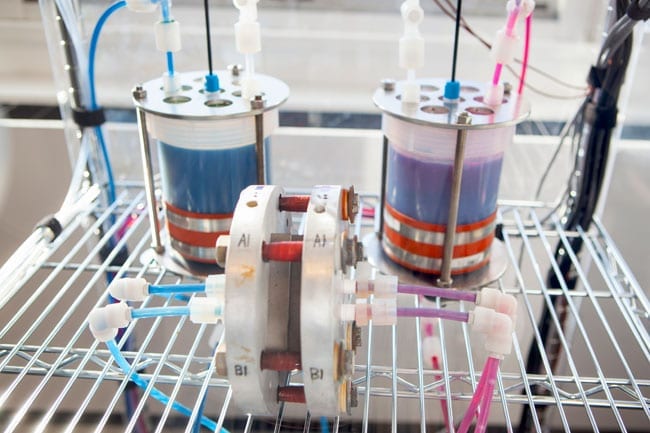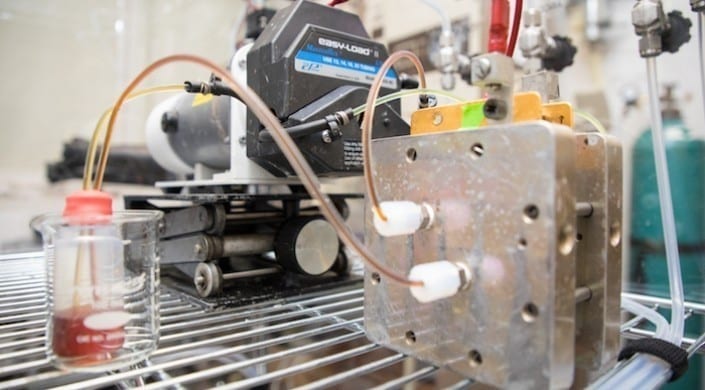
The new flow battery developed by the Harvard team already performs as well as vanadium flow batteries, with chemicals that are significantly less expensive, and with no precious metal electrocatalyst.
A team of Harvard scientists and engineers has demonstrated a new type of battery that could fundamentally transform the way electricity is stored on the grid, making power from renewable energy sources such as wind and solar far more economical and reliable.
The novel battery technology is reported in a paper published in Nature on January 9. Under the OPEN 2012 program, the Harvard team received funding from the U.S. Department of Energy’s Advanced Research Projects Agency–Energy (ARPA-E) to develop the innovative grid-scale battery and plans to work with ARPA-E to catalyze further technological and market breakthroughs over the next several years.
The paper reports a metal-free flow battery that relies on the electrochemistry of naturally abundant, inexpensive, small organic (carbon-based) molecules called quinones, which are similar to molecules that store energy in plants and animals.
The mismatch between the availability of intermittent wind or sunshine and the variability of demand is the biggest obstacle to getting a large fraction of our electricity from renewable sources. A cost-effective means of storing large amounts of electrical energy could solve this problem.
The battery was designed, built, and tested in the laboratory of Michael J. Aziz, Gene and Tracy Sykes Professor of Materials and Energy Technologies at the Harvard School of Engineering and Applied Sciences (SEAS). Roy G. Gordon, Thomas Dudley Cabot Professor of Chemistry and Professor of Materials Science, led the work on the synthesis and chemical screening of molecules. Alán Aspuru-Guzik, Professor of Chemistry and Chemical Biology, used his pioneering high-throughput molecular screening methods to calculate the properties of more than 10,000 quinone molecules in search of the best candidates for the battery.
Flow batteries store energy in chemical fluids contained in external tanks—as with fuel cells—instead of within the battery container itself. The two main components—the electrochemical conversion hardware through which the fluids are flowed (which sets the peak power capacity), and the chemical storage tanks (which set the energy capacity)—may be independently sized. Thus the amount of energy that can be stored is limited only by the size of the tanks. The design permits larger amounts of energy to be stored at lower cost than with traditional batteries.
By contrast, in solid-electrode batteries, such as those commonly found in cars and mobile devices, the power conversion hardware and energy capacity are packaged together in one unit and cannot be decoupled. Consequently they can maintain peak discharge power for less than an hour before being drained, and are therefore ill suited to store intermittent renewables.
“Our studies indicate that one to two days’ worth of storage is required for making solar and wind dispatchable through the electrical grid,” said Aziz.
To store 50 hours of energy from a 1-megawatt power capacity wind turbine (50 megawatt-hours), for example, a possible solution would be to buy traditional batteries with 50 megawatt-hours of energy storage, but they’d come with 50 megawatts of power capacity. Paying for 50 megawatts of power capacity when only 1 megawatt is necessary makes little economic sense.
For this reason, a growing number of engineers have focused their attention on flow battery technology. But until now, flow batteries have relied on chemicals that are expensive or difficult to maintain, driving up the energy storage costs.
The active components of electrolytes in most flow batteries have been metals. Vanadium is used in the most commercially advanced flow battery technology now in development, but its cost sets a rather high floor on the cost per kilowatt-hour at any scale. Other flow batteries contain precious metal electrocatalysts such as the platinum used in fuel cells.
The new flow battery developed by the Harvard team already performs as well as vanadium flow batteries, with chemicals that are significantly less expensive, and with no precious metal electrocatalyst.
The Latest on: Flow battery
[google_news title=”” keyword=”Flow battery” num_posts=”10″ blurb_length=”0″ show_thumb=”left”]
via Google News
The Latest on: Flow battery
- Researchers repurpose commonplace chemical with incredible properties in new battery design: 'Exhibited remarkable cycling stability'on May 1, 2024 at 5:00 am
Scientists have created a new type of battery for grid energy storage by repurposing a chemical commonly used in water treatment plants. They say it has huge potential to increase grid resiliency.
- Redflow lands second US defence battery contracton April 30, 2024 at 6:02 pm
Queensland flow battery company Redflow has won a second deal with the United States Department of Defence to supply a non-lithium energy storage solution that will be deployed to improve energy ...
- SES AI partners with WPI to develop lithium-metal battery recycling technologyon April 30, 2024 at 5:00 pm
His research lab at WPI focuses on the study of new electrodes and materials for energy storage, including lithium-ion batteries; supercapacitors; flow batteries; battery manufacturing; battery safety ...
- Standardized power management could extend EV battery rangeon April 30, 2024 at 6:32 am
The automotive industry is being pushed to establish a standard to manage the power flow to electronic control units that govern different parts of the vehicle depending on the context.
- Tribal company and Oregon battery startup create unique partnership in pursuit of clean energyon April 29, 2024 at 2:03 pm
A startup developing long-duration batteries is teaming up with a Pacific Northwest tribe to build innovative energy storage devices.
- Batteries Newson April 28, 2024 at 5:00 pm
The team use water to replace organic electrolytes -- which enable the flow of ... Road to Better Performing Batteries Using Less Critical Raw Materials Feb. 20, 2024 — Researchers are ...
- 3 Battery Stocks That Could Be Multibaggers in the Making: April Editionon April 28, 2024 at 3:30 am
InvestorPlace - Stock Market News, Stock Advice & Trading Tips Battery stocks have been depressed in the last few quarters. That does not ...
- IDTechEx Discusses Future Market Penetration of the Redox Flow Batteryon April 25, 2024 at 8:35 am
BOSTON, April 25, 2024 /PRNewswire/ -- The evolution of the redox flow battery over several decades has seen various chemistries being developed, commercialized, or even abandoned due to factors ...
- IDTechEx Discusses Future Market Penetration of the Redox Flow Batteryon April 25, 2024 at 6:35 am
The evolution of the redox flow battery over several decades has seen various chemistries being developed, commercialized, or even abandoned due to factors such as poor electrochemical reversibility ...
- CleanTech Strategies Selected by U.S. Department of Energy to Advance Innovations in Flow Batteries, with Close Industry Collaborationon April 23, 2024 at 2:07 pm
DOE selects CTS for $5 million award to support collaborative R&D by industry partners and research institutions to accelerate long duration energy storage by flow batteries.
via Bing News










